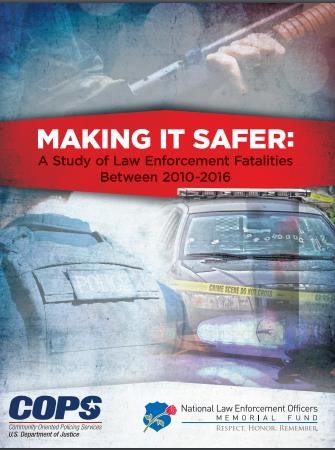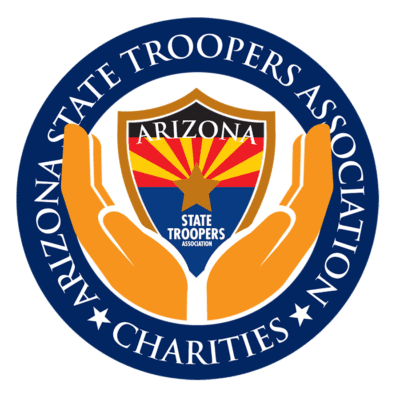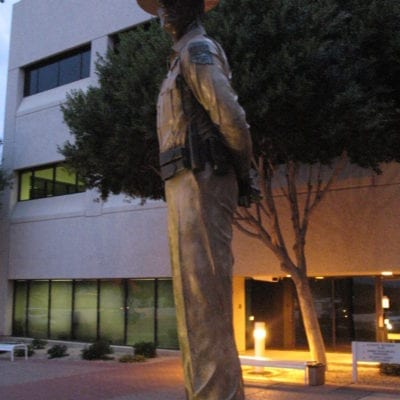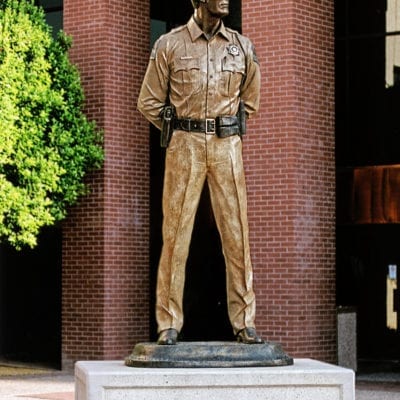Author: Chief Joel F. Shults, Ed.D.
One of the most glaring information gaps in law enforcement is data on the actual dangers of being a police officer. A recent report from the National Law Enforcement Officers Memorial Fund and the U.S. Department of Justice aims to close that gap with an analysis of 1,016 line-of-duty deaths over a seven-year period from 2010 to 2016.
The report – Making It Safer: A Study of Law Enforcement Fatalities Between 2010-2016 – is a very readable, relevant and usable publication that deserves attention from every police officer, supervisor, trainer and policy maker.
Insights in the report include the dramatic spikes in shots fired calls and police ambushes, and dangers of self-initiated officer activity compared to calls for service. Training and policy concerns are significant in the findings related to domestic violence calls, and the examination of potentially preventable deaths resulting from officer safety choices to not wear ballistic armor or use seatbelts.
There are three notable findings in the report that warrant close analysis:
1. Data from 2015 and 2016 show that 41 percent of fatal calls for service were domestic-related.
The NLEOMF report expands on the validation of what trainers have realized for years – that domestic violence calls are high danger response:
“The danger of domestic-related cases is not just represented in the study of calls for service, but it appears in the ambush analysis and self-initiated analysis as well. Domestic issues are the main factor or undercurrent that runs through the fatal encounters that were analyzed.”
Between 2015-2016, more officers were shot outside residences than inside, and a number were attacked from a distance. The study found that a lack of information sharing was one factor associated with fatality. This means there was useful information available, but not communicated to all responding officers, either by dispatchers or the officers themselves. Single officer responses were more likely to result in officer deaths, even though in most cases more than one officer was dispatched but the first officer did not wait for the arrival of their assistance.
Researchers were concerned that calls for protection order violations or civil assistance in recovering belongings were not treated as domestic violence calls and often resulted in a single unit being dispatched.
“These calls are a recipe for disaster and present a great threat to the safety of the officers who must answer them” the reviews said.
The presence of one or more additional officers means that there are more resources for separating witnesses, applying aid and rescue for an injured officer, and securing the scene.
Previous reports had shown that nearly two thirds of officer deaths occurred inside the residence, but the new analysis includes ambush studies related to the domestic violence call. While most officer deaths on domestic calls were perpetrated with a handgun, an increasing number of incidents involved rifles and distances of over fifty feet.
2. From 2012-2016, 47 percent of officers killed in fatal crashes were not wearing their seatbelt.
State law enforcement agencies have the highest rate of seatbelt usage with only a quarter of those officers killed in crashes determined to have been unbelted, followed by sheriff’s department, and led by municipal police agencies, half of whose car crash fatalities involved unbelted officers.
Of interest is the finding that while slightly more than one half of single patrol car fatalities result during call responses, the other half were during routine activities.
Typical excuses for not wearing a seatbelt include worries of constraints on rapid exit from the patrol car or a belief that belts are needed only on high speed responses and pursuits. The facts could not be clearer that those concerns are far outweighed by the realities of this, and other, research. The implications for supervisors and field training officers is clear.
3. Police-on-police shootings are preventable.
The report calls fatal accidental shootings of fellow officers “the worst mistake.” These shootings represent five percent of officer fatalities by gunfire.
The researchers in this category explored cases dating to the 19th century in order to gain a broad perspective on the issue. They included all wounds in addition to fatalities. In those cases involving training, deaths on the range, during scenario and weapons retention training, a rigorous policy and inspection for live rounds is essential. As expected, the recognition of a person at a confusing scene as a police officer is crucial. Officers responding in plain clothes and with multiple agencies involved are most vulnerable.
Being shot in crossfire situations may be an officer’s greatest fear, but the numbers show that negligent discharges, non-intentional self-injury, mistaken identity, and training incidents are all significantly greater risks.
Reducing officer deaths is more than a survival mindset
Law enforcement leaders have never had more access to information than they have today. Ignoring data in the development of policy and procedure that informs relevant training is not only lazy but can be deadly. In less than 80 pages of text, graphs, real-life case studies and bulleted recommendations, decision-makers can gather enough information to collaborate with supervisors and trainers to measure their practices against what we know causes death and injury for officers. Download the study, turn off your phone, pour a cup of coffee and read. It could save a life.






